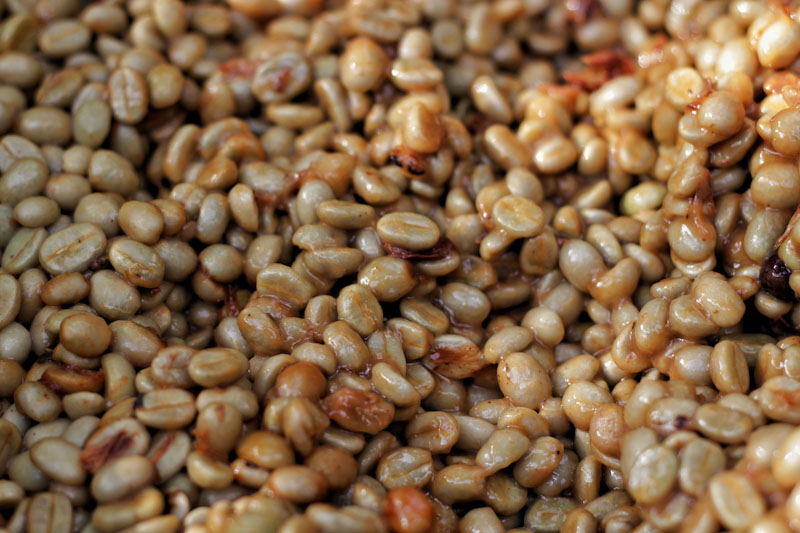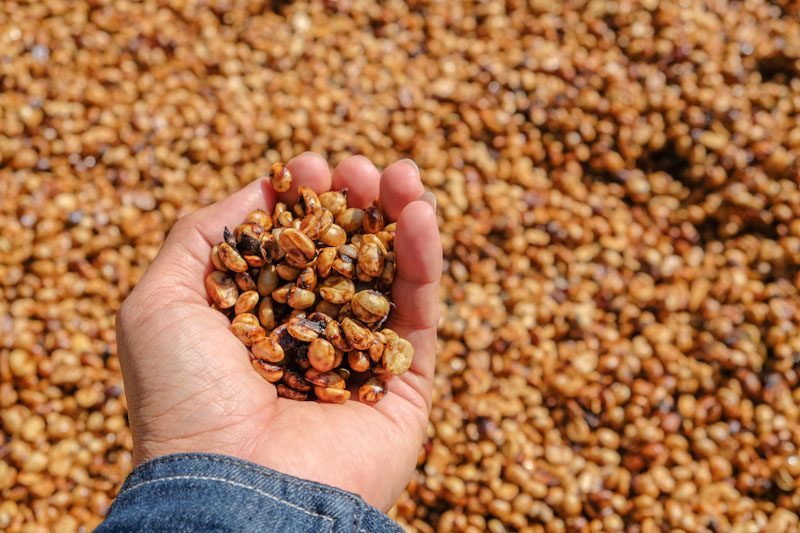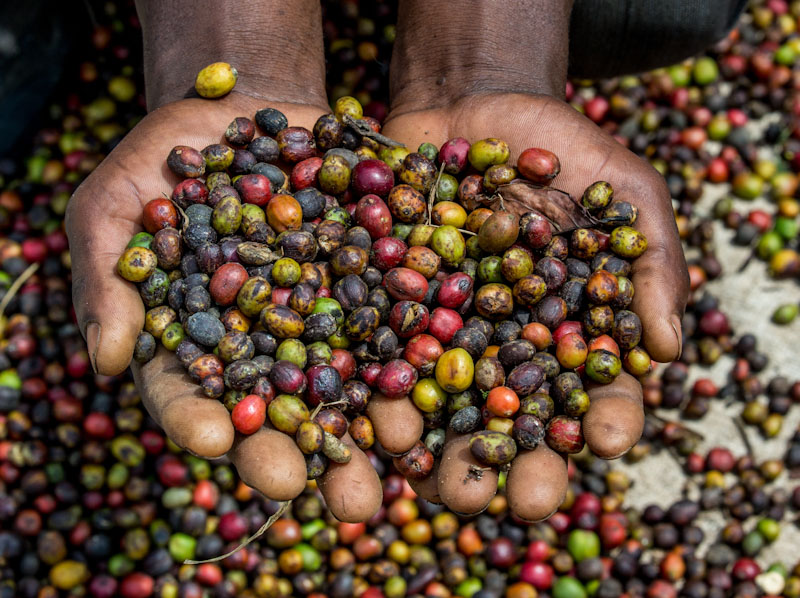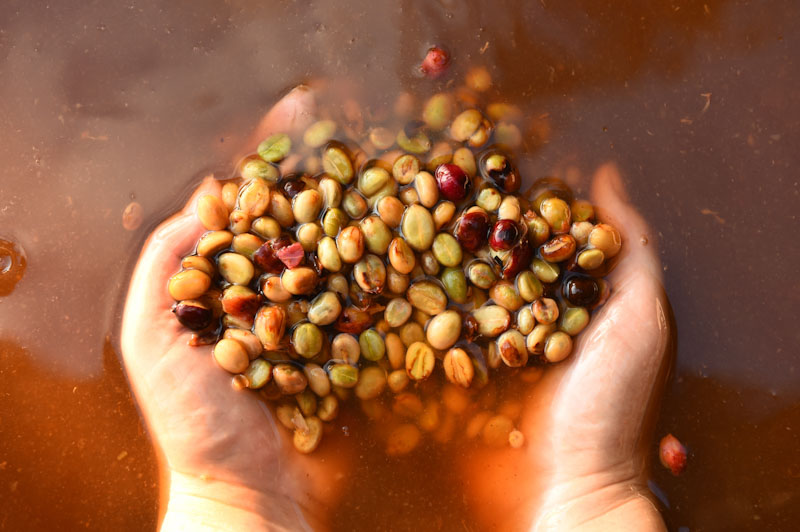COFFEE FERMENTATION
Coffee fermentation is not only a hot topic in the coffee industry, but it has shown to be the secret behind the quality of a cup of excellence.
We have spoken to one of the coffee farmers in Colombia, Elkin Guzman from Finca El Mirador in Pitalito, Huila, who is world-wide known for his experimentation with different fermentation processes. He has given us access to the technicalities behind his art.
WHAT IS FERMENTATION?
Fermentation has been used since the Neolithic age to produce all sorts of alcoholic beverages and pickles. Fermentation is defined as a metabolic (a biochemical) process that turns sugars into acids, gases, or alcohol. It can be used broadly to describe the growth of micro-organisms (involving bacteria and yeasts that feed on organic substrates with high sugar contents).
These micro-organisms produce enzymes, and these enzymes allows the micro-organisms to degrade complex substrates such as pectin, starch, and fructose which is present in the peel and in the pulp of fruits, or in this case, coffee cherries.
Simply, fermentation is a natural change that happens when you put sugar and water together which are both present in coffee cherries. As soon as coffee cherries are harvested, the fermentation process will start.
This is all very interesting, because it dramatically impacts tastes. The changes in time, temperature, sugar and the type of bacteria will play a role on the final result.
Coffee lovers have decided to dispel old myths around the traditional coffee fermentation process and try new controlled fermentation methodologies. This way, they are obtaining differentiated cups of the highest quality with sweet and fruity accents and aromas, highly desired by consumers.
Fermentation processes can have a potential positive impact on a cup, adding to its winey acidity and perceived body or sweetness. It also has the potential to undermine the coffee’s character if fermentation is taken too far…it’s just a matter of how you deal with it.
In order to understand what we are talking about, you need to know what the coffee fermentation process consists of, and the different ways of carrying it out.
THE COFFEE FERMENTATION PROCESS
The bacteria and yeast complex differs from object to object, it depends on the substrate on which the fermentation is carried out. The bacteria and yeasts that ferment the grape to produce wine are different from the bacteria that ferment the cane juice to obtain rum.
These microbial complexes are also different depending on the presence or absence of oxygen. If the process occurs in the presence of oxygen, then we are talking about aerobic fermentation which usually occurs at the beginning of the fermentation process and is a short and more intense process. If it occurs in the absence of oxygen, then we are talking about anaerobic fermentation. This occurs in the fermentation vessel once the oxygen is discharged and replaced with N2, CO2, or another by-product of the fermentation process. Anaerobic fermentation is usually a slower process.
By changing micro-organism complexes and aeration conditions, fermentation products also change.
And the differences in these products are those that give a distinctive flavour to each drink or fermented food.
The fermentation method depends on the processes the coffee beans undergo after harvesting. To have a better idea on the different processes, have a look at my previous blog post; COFFEE PROCESSING.
The first step before fermentation can take place, is that the coffee beans should be separated from the peel of the cherries, this is done mechanically with the use of a de-pulping machine.
Then, it is necessary to separate the beans from the mucilage that covers them and this is where fermentation works its magic.
WASHED PROCESS FERMENTATION
During the washed/wet process, freshly de-pulped coffee beans accumulates in tanks. It stays there for a variable time between 12 and 60 hours.
During that time, bacteria and yeasts begin to break down the mucilage around the coffee bean. The mucilage is turned into a honey-like fluid that separates easily from the bean.
After fermentation, the beans are washed with clean water to remove the honey-like layer around the beans. Finally, the washed coffee is dried in the sun to obtain dry parchment coffee.
The fermentation time of coffee varies from one region to another, depending on the climate. The exact fermentation time depends on whether a coffee develops a good cup or a dirty cup.
Generally speaking, the minimum time for coffee fermentation depends on the climate. This way, coffee farmers know how many hours they must leave their coffees to ferment before washing and drying them.
When the ambient temperature under which the fermentation takes place is around 15 °C, coffees with special and delicate flavours are obtained.
On the other hand, when the fermentation time is very long and the ambient temperatures are between 18 °C and 26 °C, defects can be obtained and the final cup can be stale or sour.
When the fermentation time exceeds 42 hours, cups with defects such as sour, wood, stale and earthy flavour can be obtained.

Washed Process Fermentation
TYPES OF FERMENTATION
There are two traditional ways of fermenting coffee: solid and submerged forms.
In the solid form, the de-pulped beans are left alone in a tank for enough time to achieve the desired fermentation level.
In the submerged form, water is added to the tank which contains the beans in a proportion of 30% of the whole coffee mass – 30 litres of water for every 100 kilos of coffee beans.
Under the same environmental conditions, the solid fermentation process takes place in less time compared to the submerged process.
The submerged process has two advantages:
- Fermentation occurs more uniformly over the entire coffee mass.
- A higher pH is maintained during this process than in the solid fermentation.
Through submerged fermentation, very soft cups with notes of caramel are obtained, while in solid fermentation, cups which are more complex are obtained with fruity, citric and chocolate notes.
THE WASHING
Fermented coffee should be washed with good quality water.
Between 2 to 4 washes should be performed according to the desired cup profile :
- In order to obtain coffees with intense, sweet, fruity flavours and tartaric acidity, one or two gentle washes should be carried out.
- For much softer cups with hints of caramel, 4 washes should be performed before drying the coffee in layers no more than 4cm thick.
Controlled fermentation processes in coffee varieties such as Bourbon, Geisha, Tabi or Maragogipe, provide better cups than genetically improved coffee varieties.
RECOMMENDATIONS
- Consumers increasingly demand quality and variety in their coffee cup profiles.
- Differentiated coffee cup profiles can only be obtained through controlled fermentation processes.
- Regardless of the fermentation protocol carried out, the cleaning conditions of the facilities and the quality of the water must be optimal to avoid quality defects in the cup.
- There are as many controlled fermentation protocols as there are coffee farmers and coffee farms.
- Each coffee farmer must experiment until obtaining the fermentation protocols that provide the best results according to their particular climate conditions and cultivated coffee varieties. You should be able to replicate that fermentation protocol over and over again, to ensure consistency in cup quality of your coffee.
Double fermentation and Honey coffee
Honey coffee tends to give a very sweet cup that is obtained through a process that combines double fermentation and the absence of subsequent washing (Semi-washed process).
The first fermentation consists of leaving the freshly picked coffee cherries to rest in a cool place.The rest period can last between 24 and 40 hours. Cherries should be arranged in layers of maximum 15cm thick to prevent the temperature from rising too high during this process.
At this time, fermentation begins within the coffee cherry where the mucilage still remains in contact with the beans.
Once the first fermentation in cherry form has passed, the coffee then undergoes the de-pulping process.
According to the controlled fermentation protocol, beans can be:
- Directly taken to the drying beds.
- Allowed to ferment in the tanks for 12 and 16 hours further, before being dried (This is the second fermentation).
Within honey processed coffees, there are 3 types: black, red and yellow. See my blog HONEY PROCESSED COFFEE
Here, the difference lies in the drying process;
- Yellow honey coffee is dried in the sun.
- Red honey dries half the time in the shade and the other half in the sun.
- Black honey dries entirely in the shade and drying can take up to a month.
This longer drying time implies that the sticky mucilage will still be attached to the coffee bean while it continues to ferment during the first days of drying.
For this reason, honey coffees are sweeter and they develop flavours and aromas of fruits, hazelnuts, walnuts, chocolate, spices, and different types of acidity such as tartaric. These flavours and type of acidity do not occur in mild washed coffees.

Honey Process Fermentation
SO WHAT ABOUT FERMENTATION IN NATURAL COFFEES?
As you already know, natural coffees are those in which the whole cherries are dried in the sun.
In other words, there is no de-pulping or fermentation process in tanks.
Only the process of the first fermentation of the coffee cherries is carried out and then the beans are dried.
In this case, the drying time is even longer when compared to that of a mild washed coffee or a honey coffee.
During the first week of drying, while the coffee cherries still have sufficient humidity, the fermentation process remains active.

Natural Process Fermentation
The fact that the fermentation takes place inside the cherry results in intense, very sweet cup profiles with tartaric acidity and notes of wine, plum and tropical fruits…making natural processed coffees a hit in the coffee market.
Carbonic Maceration is currently one of the fermentation processes most sought after by roasters, and one of Elkin’s specialty trades. I will discuss this in more detail in my next blog…keep a lookout.
Thanks to:
Elkin Guzman. Finca El Mirador. Pitalito, Huila, Colombia
Petrich, I., 2020. Coffee Fermentation: What Is It & How Can It Improve Coffee Quality? – Perfect Daily Grind. [online] Perfect Daily Grind. Available at: <https://perfectdailygrind.com/2018/06/coffee-fermentation-what-is-it-how-can-it-improve-coffee-quality/> [Accessed 26 May 2020].
Huch, M. and Franz, C., 2015. Coffee: fermentation and microbiota. Advances in Fermented Foods and Beverages, [online] pp.501-513. Available at: <https://www.sciencedirect.com/science/article/pii/B9781782420156000219> [Accessed 26 May 2020].
org. Fermentation Of Coffee – Control Of Operation. [online] Available at: <http://www.ico.org/projects/Good-Hygiene-Practices/cnt/cnt_en/sec_3/docs_3.3/fermentation.pdf> [Accessed 26 May 2020].


Recent Comments